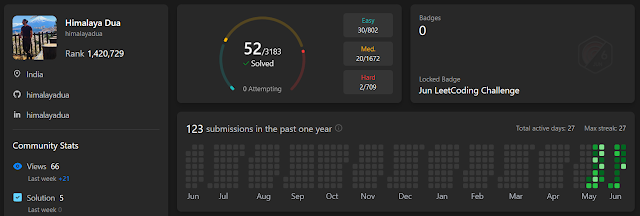Why Every Developer Should Use LeetCode
"Whether LeetCode is worth it depends on your goals"
This blog is part of my leetcode journey blog and you can access the complete list here.
- Mind Mapping the Algorithmic Challenge - Blind75
- Why Every Developer Should Use LeetCode
- Leetcode - Blind75 - Easy
Why Every Developer Should Use LeetCode
In the ever-evolving landscape of software development, staying sharp and current with coding skills is not just an advantage; it’s a necessity. LeetCode has emerged as an indispensable tool for developers aiming to hone their problem-solving abilities and technical prowess. Here’s why LeetCode is a must for all developers:
1. Interview Preparation
LeetCode’s extensive collection of coding challenges is tailored to mirror the types of questions asked in technical interviews at leading tech companies. By practicing these problems, developers can gain familiarity with the interview format and question types, boosting their confidence and performance during actual interviews.
2. Mastery of Data Structures and Algorithms
Regular practice on LeetCode helps developers deepen their understanding of data structures and algorithms—a fundamental skill set for any serious coder. This knowledge is not only crucial for interviews but also for writing efficient and scalable code in a professional setting.
3. Keeping Skills Up-to-Date
The tech industry is dynamic, with new languages and frameworks emerging constantly. LeetCode provides resources and tutorials that help developers stay abreast of the latest trends and technologies.
4. Community and Competition
LeetCode has a vibrant community where developers can discuss solutions, share interview experiences, and learn from each other. The competitive aspect of LeetCode also adds a fun and motivating dimension to the learning process.
What is Blind 75?
The Blind 75 is a curated list of 75 LeetCode questions that cover the most common types of problems encountered in coding interviews. It was created by a software engineer during his job search and gained popularity for its effectiveness in preparing candidates for technical interviews. The list is named after the career-centric forum “TeamBlind,” where it was first shared.
The Blind 75 focuses on key areas such as arrays, binary manipulation, dynamic programming, graphs, and more. It’s designed to provide a comprehensive study plan that ensures coverage of the essential topics required for coding interviews.
In conclusion, LeetCode and the Blind 75 list serve as powerful resources for developers at all levels. Whether you’re a beginner looking to break into the industry or an experienced developer aiming to keep your skills sharp, LeetCode is a valuable asset in your professional development arsenal.
Blind 75
-
Blind 75 -
Easy - 19 Questions -
Medium - 50 Questions -
Hard - 6 Questions
-
Question List
- Two Sum
- Longest Substring Without Repeating Characters
- Longest Palindromic Substring
- Container With Most Water
- 3Sum
- Remove Nth Node From End of List
- Valid Parentheses
- Merge Two Sorted Lists
- Merge k Sorted Lists
- Search in Rotated Sorted Array
- Combination Sum
- Rotate Image
- Group Anagrams
- Maximum Subarray
- Spiral Matrix
- Jump Game
- Merge Intervals
- Insert Interval
- Unique Paths
- Climbing Stairs
- Set Matrix Zeroes
- Minimum Window Substring
- Word Search
- Decode Ways
- Validate Binary Search Tree
- Same Tree
- Binary Tree Level Order Traversal
- Maximum Depth of Binary Tree
- Construct Binary Tree from Preorder and Inorder Traversal
- Best Time to Buy and Sell Stock
- Binary Tree Maximum Path Sum
- Valid Palindrome
- Longest Consecutive Sequence
- Clone Graph
- Word Break
- Linked List Cycle
- Reorder List
- Maximum Product Subarray
- Find Minimum in Rotated Sorted Array
- Reverse Bits
- Number of 1 Bits
- House Robber
- Number of Islands
- Reverse Linked List
- Course Schedule
- Implement Trie (Prefix Tree)
- Design Add and Search Words Data Structure
- Word Search II
- House Robber II
- Contains Duplicate
- Invert Binary Tree
- Kth Smallest Element in a BST
- Lowest Common Ancestor of a Binary Search Tree
- Product of Array Except Self
- Valid Anagram
- Meeting Rooms
- Meeting Rooms II
- Graph Valid Tree
- Missing Number
- Alien Dictionary
- Encode and Decode Strings
- Find Median from Data Stream
- Serialize and Deserialize Binary Tree
- Longest Increasing Subsequence
- Coin Change
- Number of Connected Components in an Undirected Graph
- Counting Bits
- Top K Frequent Elements
- Sum of Two Integers
- Pacific Atlantic Water Flow
- Longest Repeating Character Replacement
- Non-overlapping Intervals
- Subtree of Another Tree
- Palindromic Substrings
- Longest Common Subsequence
All the best!


Comments
Post a Comment